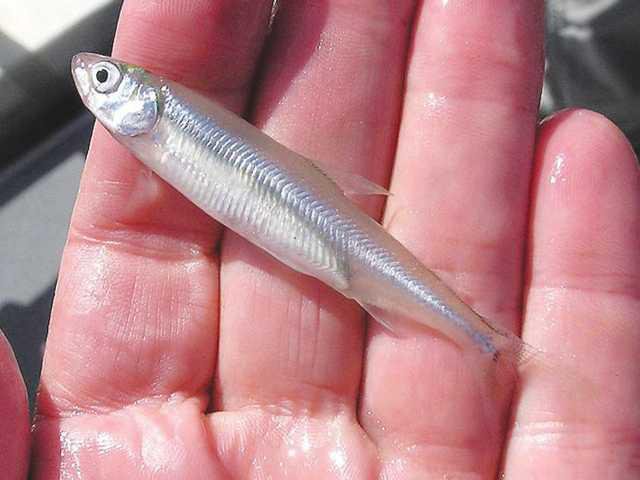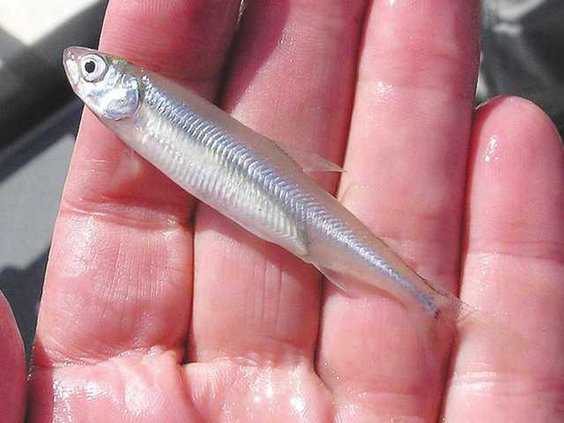Editor’s note: This is part of an occasional series on rivers, lakes, reservoirs, the Delta and the weather that play a key role in supplying Manteca Ripon, Lathrop and much of the rest of California with water.
It smells like cucumbers.
It tops out at 4 inches in length.
It is a luminous silvery blue color.
That is what a Delta smelt looks and smells like in a nutshell.
At one point the fish that have a one-year life cycle were so plentiful that they were caught and sold commercially.
Today the fish that are unique to the San Joaquin-Sacramento Delta are on the verge of extinction in the wild.
Trawler surveys conducted by state crews in March 2016 turned up just six Delta smelt.
The fish plays a pivotal role in California’s perennial water wars. Its shaky survival status has triggered orders to shut down the pumps near Tracy that send water into the California Aqueduct and Delta-Mendota Canal at pivotal points in the Delta smelt’s life cycle in the spring.
When the pumps are running the Delta smelt get sucked in and killed.
The Delta smelt has also benefitted from massive releases of stored water to send more fresh water into the Delta in a bid to to help them. Those releases have been criticized by farmers in the southern end of the San Joaquin Valley who argue the water is simply going out to sea and not being diverted for human uses especial during drought periods. They point to surveys of Delta smelt populations before and after such massive releases and note the decline in numbers hasn’t been slowed down.
The four-year drought has made the situation worse for the Delta smelt.
The Delta smelt is listed as an endangered species. It is also considered an indicator species. In other words, when the numbers drop it is a sign that the Delta’s ecological system may be failing other fish as well such as the Chinook salmon.
Two factors are believed to weigh heavily on the Delta smelt’s fate. The biggest is the reduction in fresh water in the Delta since water started flowing southward via the California Aqueduct in the 1960s.
The movement of water from the north state to the south state is blamed for the overall decline of the Delta ecological system by allowing water salinity to increase. Some believe putting in place either the Peripheral Cabal as was proposed more than 30 years ago by then Gov. Jerry Brown or the Twin Tunnels now being pursued by the Brown Administration would accelerate brackish conditions in the Delta hurting the Delta smelt and other fish.
With the Twin Tunnels or without, the state has indicated it wants to increase unimpaired flows on the Stanislaus, Merced, and Tuolumne rivers to send more fresh water into the Delta. Taking the water bound for Los Angeles out of the Delta ecological system by moving it below ground is expected to increase the need to replace it with water from elsewhere.
That poses a threat to those that rely on water from those three rivers’ watersheds including the South San Joaquin Irrigation District and the cities it serves including Manteca and Lathrop.
The other threat to Delta smelt are larger fish particularly non-native striped bass and largemouth bass that were introduced to the Delta by man. Those fish bring a fourth player to the water wars centered around the Delta in addition to Delta area farmers and cities, Southern California cities and southern San Joaquin Valley farms, and environmentalists — sports fishermen.
Several scientists are predicting that the Delta smelt can’t survive in the wild given massive releases if fresh water hasn’t helped their lot.
There are Delta smelt being bred in programs at the University of California at Davis and at a fish hatchery near Shasta Dam.
The health of the ecological system and the need for water that is being commandeered by courts to help the Delta smelt is why the 4-inch fish has become — depending upon how you look at things — the poster fish for all that is wrong with California water development or the whipping fish for how state water policy has been skewed.
Delta smelt: Water war linchpin
How they are dealt with may impact SSJID farmers, Manteca & Lathrop



